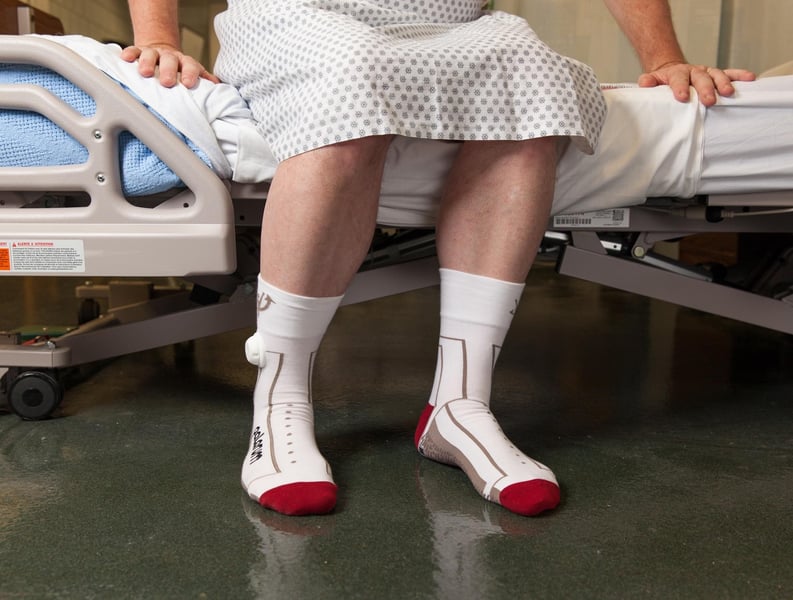Get Healthy!

- Denise Mann
- Posted August 30, 2022
High-Tech Socks Could Prevent Falls in At-Risk Patients
Every year, anywhere from 700,000 to 1 million people fall while in U.S. hospitals, and this often triggers a downward health spiral.
Little has been shown to make a dent in those numbers. Until now.
Enter Smart Socks, which are wired with sensors that send an alert when a patient tries to get up from a hospital bed and puts pressure on the socks.
In a 13-month study, nobody who wore the socks fell, which equaled a rate of 0 falls per 1,000 patient-days. Patient-days refers to the number of falls and the number of occupied bed days on a hospital unit over a study period. Historically, this rate is 4 falls per 1,000 patient-days.
"While further study is needed, I do believe there is an opportunity for these socks to be used in inpatient hospital settings, nursing homes and rehab facilities,"said study author Tammy Moore. She's the associate chief nurse at Ohio State's Neurological Institute and Medical Surgical in Columbus.
The study was funded by Palarum's PUP (Patient is Up) Smart Socks, but Moore and colleagues have no financial ties to the company.
For the study, 569 people who were at high risk for falling in the hospital wore the socks. No other fall prevention systems, such as chair or bed alarms, were used. There were 5,010 alarms sounded by the socks during the study period, and 11 of these were considered false alarms, indicating that 99.8% of the alarms correctly alerted nurses when a person attempted to stand.
When the socks detect an attempt to stand up, the system alerts the three nurses closest to the alarm via wearable smart badges. If no one responds within one minute, the call goes out to the next three closest nurses. If no one responds within 90 seconds, the system alerts everyone with a smart badge.
Nurse response times ranged from one second to nearly 10 minutes, with an average of 24 seconds, the study showed. There wasn't any information on nurse response times for bed and chair pressure sensors available for comparison.
Now, researchers plan to test the sock system in a variety of units at the hospital, Moore said. "We believe that there is efficacy of the product but it needs to be tested in a variety of settings and [on] more patients,"she explained.
The study was published online recently in the Journal of Nursing Care Quality.
As the co-chair of the Falls Oversight Committee at Rush University Medical Center in Chicago, Megan Dunning is always looking for innovative ways to prevent her patients from falling.
"I think there is a role for the socks in fall prevention in an inpatient setting,"said Dunning, who reviewed the new study.
"The evidence in the article makes a pretty big statement, since the unit had 0 falls during the pilot period, [and it] also seems promising that the nurse response times were quick, as nurses knew that the chance this was a false positive was low," Dunning said.
Cost may be a factor for hospitals who are considering implementing this type of system, she noted.
One of the only things that has been found to decrease falls is walking around, she added. "Mobilizing patients while they are in the hospital, to prevent deconditioning and complications, can be very effective in reducing falls,"Dunning said.
Dr. Catherine Sarkisian, a geriatrician and professor at the University of California, Los Angeles, agreed that getting people up and walking is really important.
Unfortunately, these socks would force people to stay in bed.
"Staying in bed is a very strong driver of new disability for older adults who are hospitalized,"she said. "Even if the Smart Socks actually prevented falls in the hospital, it might cause more disability and frailty, so that when patients go home they are weaker and more likely to fall at home."
Still, the research "addresses a huge problem since injurious falls in the hospital are very common and not only hurt, but literally kill, patients every year,"said Sarkisian.
It's too early to draw any conclusions about what role these socks may play in preventing falls in the hospital, said Sarkisian.
There is not much else that is shown to prevent falls among people in the hospital, she noted. Despite their widespread use, bed and chair pressure sensors don't really prevent falls.
"The one intervention that has been shown to work is for patients with known low vitamin D levels: that is to replete the vitamin D in those patients and that does decrease falls,"Sarkisian said.
More information
The U.S. National Institute on Aging has more tips on how to prevent falls and fractures.
SOURCES: Tammy Moore, associate chief nurse, Ohio State's Neurological Institute and Medical Surgical, Columbus; Megan Dunning, manager, physical therapy, and co-chair, Falls Oversight Committee, Rush University Medical Center, Chicago; Catherine Sarkisian, MD, MSHS, geriatrician, professor, division of geriatrics, University of California, Los Angeles; Journal of Nursing Care Quality, Aug. 19, 2022, online






